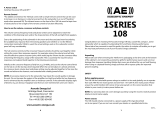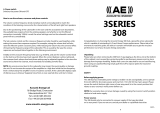
3
Section 1: Important Safety Instructions
1. Read these instructions.
2. Keep these instructions.
3. Heed all warnings.
4. Follow all instructions.
5. Do not use this apparatus near water.
6. Clean only with dry cloth.
7. Do not block any ventilation openings. Install in
accordance with manufacturer’s instructions.
8. Do not install near any heat sources such as
radiators, heat registers, stoves or other apparatus
that produce heat.
9. Do not defeat the safety purpose of the grounding type
plug. A polarized plug has two blades with one wider
than the other. A grounding type plug has two blades
and a third grounding prong. The wide blade or the third
prong is provided for your safety. If the provided plug
does not t into your outlet, consult an electrician for
replacement of the obsolete outlet.
10. Protect the power cord from being walked on or pinched
particularly at plugs, convenience receptacle and the
point where the power cord connects to the apparatus.
11. Only use attachments/accessories specied by
the manufacturer.
12. Unplug this apparatus during lightning storms or
when unused for long periods of time.
13. Refer all servicing to qualied service personnel.
Servicing is required when the apparatus has been
damaged in any way, including: power-supply cord or
plug is damaged, liquid has been spilled or objects
have fallen into the apparatus, the apparatus has been
exposed to rain or moisture, does not operate normally,
or has been dropped.
14. The appliance coupler of the power supply cord is used
as the ultimate disconnect device from the mains. The
appliance coupler shall remain readily operable.
15. The apparatus shall be connected to mains socket outlet
with a protective earthing connection.
Any changes or modications not expressly approved
by the party responsible for compliance could void the
user's authority to operate the equipment.
This equipment has been tested and found to comply
with the limits for a class B digital device, pursuant to
part 15 of the FCC Rules. These limits are designed
to provide reasonable protection against harmful
interference in a residential installation. This equipment
generates, uses and can radiate radio frequency energy
and, if not installed and used in accordance with the
instructions, may cause harmful interference to radio
communications. However, there is no guarantee that
interference will not occur in a particular installation.
If this equipment does cause harmful interference to
radio or television reception, which can be determined
by turning the equipment off and on, the user is
encouraged to try to correct the interference by one
or more of the following measures:
•
Reorient or relocate the receiving antenna.
•
Increase the separation between the equipment
and receiver.
•
Connect the equipment into an outlet on a circuit
different from that to which the receiver is connected.
•
Consult the dealer or an experienced radio/ TV
technician for help.
CAN ICES-3(B)/NMB-3(B)
Explanation of Graphic Symbols
The exclamation point within an equilateral
triangle is intended to alert the users to
the presence of important operating and
maintenance (servicing) instructions in the
literature accompanying the product.
The lightning ash with the arrowhead symbol,
within an equilateral triangle, is to alert the
user to the presence of insulated “dangerous
voltage” within the products enclosure that may
be of sufcient magnitude to constitute a risk of
electric shock to humans.
CAUTION: TO REDUCE THE RISK
OF ELECTRONIC SHOCK - DO NOT
REMOVE COVER. NO USER SERVICEABLE
PARTS INSIDE. REFER SERVICING TO
QUALIFIED PERSONNEL. DO NOT EXPOSE
THIS APPARATUS TO RAIN OR MOISTURE.
WARNING:
•
To reduce the risk of re or electrical shock, do not
expose the apparatus to rain or moisture.
•
The apparatus shall not be exposed to dripping or
splashing and no objects lled with liquids, such as vases,
shall be placed on the apparatus. As with any electronic
product, use care not to spill liquids into any part of the
system. Liquids can cause a failure and/or a re hazard.
























